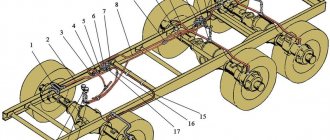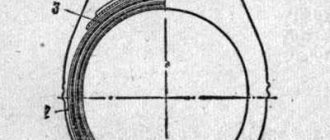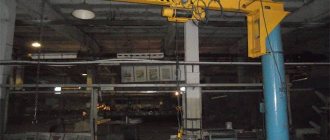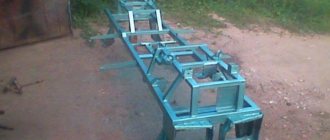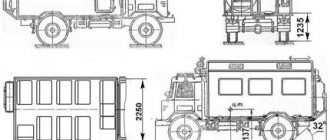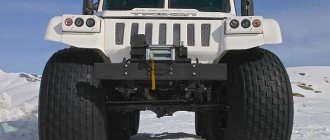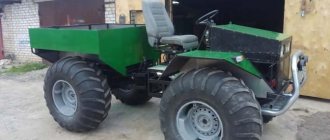Any driver of a truck or car must monitor tire pressure. To avoid problems, it is enough to devote some time to this process once a week. Rough roads, potholes, speed bumps, curbs and other obstacles cause tire pressure to drop. In the summer, a tire explosion is not a rare occurrence; the consequences of this can be terrible, and the reason is over-inflating the tires and ignorance of physics (air expands when heated).
Checking tire pressure
Nowadays, tubeless tires are in fashion and are considered the most pressure sensitive. Fluctuations in this indicator by only 15-20% from the norm increase tire wear by almost 30%, which will have a significant impact on road safety.
Rules for storage and transportation. Valdai tire pressure
It’s not for nothing that the GAZ 33106 car bears the nickname “Hard Worker”.
It was as if he was called to serve the people. In connection with superstructures there is a grain van, mobile workshops and laboratories, special vehicles, tow trucks and flatbeds. A large number of companies and institutions intensively use it for their own purposes. Before considering other modifications, let’s look at the technical characteristics of the basic GAZ 33106 Valdai.
GAZ 34039: technical characteristics, modifications (GAZ 34039 32 and GAZ 34039 33) photos, videos.
Read the review of GAZ 53 in this article.
Find out more about the KrAZ 255 and its characteristics in the article.
History and design features of the GAZ-33106 "Valdai"
Maneuverability was not a big concern for Valdai’s predecessors, the medium-tonnage trucks of the GAZ-3307 family. Which, as you know, were developed back in the 80s of the twentieth century and were designed for operation mainly in rural areas. And in the cities then it was not at all as crowded as in our era.
The Valdai, unlike its predecessor, has a lower landing (the loading height of the loaded vehicle is only 985 mm). The reduction in loading height was also facilitated by the replacement of traditional GAZ 20-inch wheels with 17.5-inch wheels familiar to European delivery trucks.
Of course, in terms of cross-country ability, the Valdai cannot compete with the GAZ-3307. This is primarily a “city dweller”, a delivery truck of class N-2, MCV category, for paved roads. Unlike the Gazelle, a category B license to drive a Valdai will not be enough: it requires a category C license.
Standard Valdai with a van on the roads.
The first samples of the Valdai truck were created in collaboration with the Minsk Automobile Plant back in 1999. However, in the end, MAZ was ahead of the Nizhny Novgorod residents, being the first to launch its low-frame, medium-tonnage vehicle, the five-ton MAZ 4370 Zubrenok, into mass serial production.
There was an idea to equip a GAZ medium-duty truck with a cabless cab like the MAZ-5336, but it did not receive a concrete implementation. It was decided to use the mass-produced cabin of the Nizhny Novgorod superbestseller, the Gazelle.
Moreover, under the hood of the engine compartment of this cabin, which, as is known, is designed for a short 4-cylinder engine, it turned out to be quite compact to place the in-line 6-cylinder diesel engine GAZ-562 (licensed Steyr, the first Valdai engine) ). This made it possible, despite the engine cover sliding forward, to maintain space for a second passenger in the middle. That is, the cabin can be described as a “conditionally three-seater” for short trips and a two-seater for long and long-distance trips.
Externally, the GAZ-33106 Valdai is very similar to the Gazelle, but at the same time, it is noticeably different from it with its massive bumper and radiator grille, as well as more impressive dimensions. With a similar cabin and external similarity, the Valdai looks much more serious: its width and height are greater than those of the Gazelle by 284 and 125 mm, respectively.
Details about Valdai engines are below. Although at first the choice was made, for economic reasons, in favor of the “tractor” MMZ D-245.7, the best of all options for Valdai was the Cummins turbodiesel (ISF).
Valdai at the autodrome.
The body structure of this truck is frame. The frame itself is assembled from side members taken from the GAZ-3307 model, with original traverses and brackets. Built on a five-ton platform, the Valdai has a significant margin of safety, allowing it to transport cargo weighing more than four tons.
As a result of the evolution of the model, the GAZ-33106 was obtained - a modern business delivery vehicle with a convenient loading height, a fairly comfortable suspension, a safe braking system and an economical diesel engine. A car that can make you good money!
Topic: Unloading dryer and safety valve
Club member
Re: Unloading dryer and safety valve
- View profile
- Forum messages
- Diary entries
- View articles
Club member
Re: Unloading dryer and safety valve
tochilin on the rush technology there are bare 3-4 circuit valves, there are no reduction gears, unlike the atego. As much as the unloading in the dryer cuts off, so does the system.
Posted by Peter Volont
Here is an example when the built-in reduction gear is not installed. l.s. Passes 12 points onto the line.
Or adjust the discharge in the dryer to 10, and this 4-circuit will outlast the car. Plus the compressor will “thank you.”
- View profile
- Forum messages
- Private message
- Diary entries
- View articles
Club member
On the cessation of production of the Valdai family
At the seventh International Specialized Exhibition “Commercial Vehicles”, held in 2006 in Moscow, the then new model of Gorky’s car was recognized as the winner in the “Best Domestic Truck” category.
The transition from Minsk diesel engines to modern Chinese-assembled Cummins engines in 2010 made the Valdai much more comfortable and quiet, unnecessary vibrations at idle went away and fuel consumption decreased. Supporters of this model have increased significantly. In this regard, the cessation of its production was received sharply negatively by many.
Historical photo: the last GAZ-33106 Valdai and its successor, GAZon Next.
The last Valdai car rolled off the assembly line of the Gorky Automobile Plant in late December 2022. To replace the Valdai, the company introduced to the market the five-ton GAZon Next truck, a modification of the City - also with a low loading height, on low-profile wheels, an urban delivery truck.
However, opinions are still expressed about the unequal value of this replacement. Compared to the Valdai Gazelle, which has small dimensions and maneuverability, the GAZon Next is called a clumsy, “elephant-like” car and, moreover, an order of magnitude more expensive. It is also noted that GAZon Next is a still “raw” and unfinished model. Such sentiments affect demand: the market accepted GAZon Next with caution, and its sales in the first years of production did not shine.
Characteristic
The GAZ car model 33073 began mass production in the USSR. The first copies were released in 1989. At the time, it was a powerful, cutting-edge truck with an impressive design and an improved cab.
A few years later, the Gorky Automobile Plant began to produce various modifications based on it. Thus, a diesel version 3309 appeared, as well as an all-wheel drive Sadko truck with the ability to remotely inflate tires from the passenger compartment. The car was mass-produced until the appearance of the Next GAZon. Gradually, the demand for 33073-GAZ fell. The market demanded a newer truck with modern technical characteristics.
Modifications of Valdai cars
Basic modifications of the Valdai - under the symbols GAZ-3310 and GAZ-33101, with a turbocharged diesel engine GAZ-562 (3.13 l, 150 hp, 420 N•m), were not brought to mass production. A modification of the GAZ-33104, equipped with a D-245.7 power unit from the Minsk Motor Plant, went into production.
GAZ-33106, equipped with a Cummins ISF turbodiesel, produced from 2010 to the end of 2022, became, as already noted, the most successful version of the Valdai. Export versions of the GAZ-33106 truck were also equipped with a Cummins CIV diesel engine.
Those. characteristics of GAZ-33073
Under the hood of the truck there is an 8-cylinder carburetor power unit from the Zavolzhsky Motor Plant. The engine received the marking 5231.10 (previously the 511th engine was installed on GAZon). The unit has an aluminum block and head, an OHV valve mechanism and a liquid cooling system.
The engine was still derated - it had a compression ratio of 7.6 kgf and ran on 76-octane gasoline. Maximum power – 124 horsepower. Working volume – 4.67 liters. Peak torque is almost 300 Nm. Fuel consumption is 20 liters per 100 kilometers. However, in practice the figure reached 25, which in today’s realities is unacceptable for a 4-ton truck. This is one of the main reasons why they stop using the GAZ-33073. The weight of the truck is large, but the volume of the cargo compartment is small. In order to somehow adapt the car to the requirements of the modern road transportation market, Chaika-Service extends the frame to 5 and 6 meters. Thus, the truck becomes more profitable. The car is also equipped with gas equipment. Both methane and propane-butane cylinders are installed here. A lot of equipment was exported to Belarus, where it is still used to this day.
Technical characteristics of the GAZ-33106 Valdai car
GAZ-33106 "Valdai" with a refrigerator van.
Dimensions and weights
Truck engine GAZ-33106 "Valdai"
GAZ-562 Steyr diesel engines were tested as a power unit for the Valdai car; three types of Iveco engines; We first chose the Minsk D-245.7 as the base one (from 2006 to 2010). Since the beginning of 2011, all Valdai trucks have been equipped with a Chinese-assembled Cummins ISF-3.8s3154 engine.
This is an in-line, 4-cylinder, 4-stroke, liquid-cooled diesel engine with a turbocharging system and charge air cooler, with direct fuel injection. The working volume of this engine is 3.76 liters. Rated power is 111 kW, or 152 hp. (at 2600 rpm).
The Cummins engine ventilation system is open. The engine uses a radial, 3-piston injection pump (high pressure fuel pump), with an electromagnetic pressure regulator, and a mechanical booster pump. Fuel supply equipment for the Common Rail system, manufactured by Bosch, brand CR/CP 3S3L110-30-789S, was installed.
"Valdai". View under the hood.
A mechanical fuel priming pump operates as part of the injection pump and a manual one operates in the housing of the coarse fuel filter. The high pressure fuel accumulator is cylindrical, with a pressure limiting drain valve. Bosch-0445 injectors equipped with an electromagnetic control valve are installed.
A combined lubrication system is used: under pressure and splashing. Oil radiator – full-flow, constantly on. The oil filter is full-flow, with a replaceable filter element. The Cummins engine uses a closed-type liquid cooling system, with forced circulation of coolant, and an expansion tank.
The turbocharging system is gas turbine, with one turbo compressor of the “HE-211W” type, with a radial centripetal turbine, with a centrifugal compressor and a tubular-plate type charge air cooler.
The Cummins ISF-3.8s3154 engine meets the requirements of the Euro-4 environmental standard. Its operating life declared by the manufacturer is 500 thousand kilometers. The maximum speed it can provide is, according to the factory, 105 km/h. Average fuel consumption is from 12 to 15 liters per 100 kilometers.
Transmission, steering and brake control GAZ-33106
The GAZ-33106 Valdai has a 5-speed gearbox with synchronizers in all gears except first. Gear ratios: gear – 6.555 gear – 3.933 gear – 2.376 gear – 1.442 gear – 1.000 Reverse –5.735.
The main gear is conical, hypoid type. Cardan transmission - two-shaft with an intermediate support, with three cardan joints on needle bearings. Bevel differential, gear. The clutch is single-disc, dry, hydraulically driven.
The modernization associated with the transition to an imported Cummins engine also affected the vehicle’s transmission. A thorough modification of the gearbox was carried out, increasing its reliability. (double-cone synchronizers, input shaft, clutch with fork). Imported diaphragm clutch parts from ZF Sachs were introduced.
The type of steering mechanism GAZ-33106 is a screw-ball nut, gear ratio is 19.8 (in the middle position). A hydraulic integral power steering is used, built into the steering mechanism. The power steering pump ( is a vane, double-acting pump. The basic equipment of the car includes cruise control, and for the modification with a double-row cab - a coolant heater.
The Valdai uses a dual-circuit braking system with a pneumatic drive. Disc brakes, all-round, with ABS and pad wear sensors. The service life of the pads is solid: it is 200 thousand kilometers. Spare brake system - each circuit of the service brake system. Parking brake system - with a pneumatic drive of the brake chambers, with spring energy accumulators installed on the disc brakes of the rear wheels.
Chassis, electrical equipment GAZ-33106
The Valdai uses four longitudinal, semi-elliptical springs with additional springs in the rear suspension. Shock absorbers are hydraulic, telescopic, double-acting. Installed on the front axle and rear suspension of the car. Disc wheels, with rim 6.00×17.5. Tires – pneumatic, radial, size 215/75R17.5.
The wiring system is single-wire, the negative terminals are connected to the car body. The nominal voltage in the network is 12V. An alternating current generator brand “5263796”, two batteries, a starter “5261035” are installed. The engine control system is microprocessor-based, with a Common Rail fuel control system.
Source
Technical characteristics of GAZ-33104 "Valdai"
Engine D-245.7 for Valdai
The D-245 engines, produced by the Minsk Motor Plant since 1984, have a successful design and enviable potential: they turned out to be very promising for performing various upgrades. On the basis of this tractor power unit, the first Minsk automobile diesel engine was developed in 1992, which found its application on ZIL “Bychok” trucks.
It is interesting that the specialists of the Likhachev Plant were also looking for a motor for their medium-tonnage truck abroad and planned to set up its own production. And the involvement of D-245 was considered as a “temporary measure.” But - “there is nothing more permanent than temporary.”
In the early 2000s, in Minsk they developed and began to constantly develop, keeping up with the times, a purely “automotive” family of D-245.7 engines. It soon received widespread use. Not only on medium-duty trucks, but also on buses.
D-245.7 for Valdai is an in-line 4-cylinder diesel engine with a displacement of 4.75 liters and a power of 122 hp, with a maximum torque of 422 Nm. This engine is equipped with a turbocharger with an intercooler (pre-cooling of charge air).
Features of the entire “.7” family are the use of modern electronics, including the Common Rail microprocessor fuel injection system; as well as periodic “adjustment” of indicators to the increasingly stringent environmental standards: Euro-1, 2, 3, and then Euro-4.
Thus, until 2005, the D-245.7 engine complied with the Euro-1 standard; until 2008 – Euro-2, until 2013 – Euro-3; and since 2013 it has been upgraded to Euro-4. However, by this time Valdai had already begun to be equipped with more modern Chinese-assembled Cummins diesel engines. But most of the Valdai trucks were produced with Minsk engines.
- Cylinder diameter – 110 mm;
- Piston stroke – 125 mm;
- Compression ratio – 17;
- Rotation speed – 2400 rpm;
- Maximum torque – 422 Nm (43.1 kg m);
- Rotation speed at maximum torque is 1500 rpm.
- Overall dimensions of the engine – 948 x 698 x 970 mm.
- Weight (in modification E-2) – 477 kg.
Modification of GAZ-331043 “Farmer”.
The D-245.7 engine is equipped with a TKR 6.1-09.03 turbocharger (“BZA”, Borisov); gear pump NSh 10ZH-Z-04L; oil pump “245-1403010”; starter “7402.3708” (24V); generator GG 273V1-3 (26V); fuel pump “773.1111005-20.05E2” (“YAZDA”, Yaroslavl).
After 2008, in the modification D-245.7 E-3, the engine received a Common Rail diesel fuel supply system manufactured by Bosch.
The MMZ D-245.7 engine fits quite freely in the Gazelevsky engine compartment. However, GAZ specialists had to change the geometry of the front axle beam: make it lower by several millimeters. From below, the motor is protected by special pallets and covered with fire-safe basalt mats. The hood, mudguards, and engine compartment panel are equipped with a noise-insulating coating. In frosty conditions, the D-245.7 engine starts up well, since there are four glow plugs in the block head.
Transmission GAZ-33104
The Valdai transmission is based on the traditional GAZon gearbox, complemented by an imported Sachs single-disc diaphragm-type clutch. The gearbox is five-speed, its crankcase is cast from an aluminum alloy and is equipped with highly developed stiffening ribs. The gearbox connector is made in a vertical plane, and this allows it to provide additional high strength and rigidity.
This “old-new” five-speed gearbox engages clearly with a slight free stroke of the lever, which allows you to quickly and effortlessly change gears (an important factor, by the way, in inner-city operating conditions). Thanks to the precise operation of the gearbox, the GAZ-33104, despite being fully loaded, accelerates confidently and briskly. The range of gear ratios is from 6.55 to 1.0. That is, fifth gear is direct.
Exotic: truck tractor based on GAZ-33104.
The clutch of GAZ-33104 "Valdai" cars is permanently closed, single-disk, dry, with a central pressure diaphragm spring and a damper device on the driven disk.
The same thing, the virtually “indestructible” unit of the same name from the “honored veteran” - the GAZ-53 truck, the famous “banjo” - was taken as the basis for the rear axle. The hypoid single-stage gearbox was retained, however, taking into account the lower engine speeds and the significantly reduced wheel diameter compared to the 53rd “GAZON”, its gear ratio was reduced. At Valdai it is 2.417 - instead of the previous value of 6.83.
Frame, chassis, suspension, steering and brakes
The entire Valdai chassis is based on the frame of the classic five-ton GAZon. Thus, there is a significant margin of safety, and overloads, as a rule, go unpunished. The frame of the GAZ medium-tonnage truck is assembled from GAZ-3307 side members, with original cross-beams and brackets. Instead of the old springs on rubber cushions, the Valdai used longer, asymmetrical, small-leaf springs. The springs are secured with pins and earrings with silent blocks. This design will give the car a noticeable smooth ride, especially when loaded.
The steering mechanism is combined with a hydraulic booster, which significantly improves the maneuverability of the Valdai and its controllability. This is one of the key points for a truck intended for use mainly in the city. The Valdai wheels can be turned at an angle of up to 45 degrees. Due to this, the turning radius is six meters - and this is only half a meter more than that of the Gazelle (with its more modest dimensions and lower weights of transported cargo).
The revolutionary difference between the Valdai and any of its predecessors and “relatives” is the use of a pneumatic brake drive. None of the cars of the Gorky Automobile Plant in its entire rich history had anything similar. It is not surprising that they decided not to “reinvent the wheel”, but to use brake mechanisms (disc on all wheels), a pneumatic compressor and ABS elements produced by reputable European and Wabco (Germany), with pneumatic system units from (Italy).
Rear axle "Valdai" assembled.
Another distinctive feature of Valdai is the fastening of wheels according to the ISO standard. On the GAZ-33104 there are now no cone nuts and fittings, but there is a seat on the hub into which a disk and six ordinary nuts and washers fit.
It is interesting that the Valdai, initially, and with the Minsk engine too, was physically a “four-tonner with a reserve.” But its capabilities were underestimated on paper so that buyers would not fall under the state requirement for licensing transportation. But on June 2, 2005, this requirement was abolished by federal law, and the need for “camouflage of the muscular capabilities” of the vehicle disappeared.
Dimensions and weight parameters of GAZ-33104
- Length: 6.050 m (standard); 7.565 m (extended version to 5 m); 8.315 m (extended version to 6 m).
- Width: mirrors 2.643 m; in the cabin 2.164 m; along the loading platform 2,350 m.
- Height, cabin: 2,245 m.
- Front overhang: 1030 mm. Rear overhang: 1710 mm (standard); 2535 mm (extended).
- Wheelbase: 3.31 m (standard); 4 and 4.75 m (extended).
- Front wheel track, width: 1,740 m. Rear wheel track, width: 1,702 m.
- Ground clearance: 177 mm.
- Loading platform, length: 3,660 m (standard); from 4.9 to 6.2 m (extended versions). Width: 2.176 m. Side height: 515 mm. Height along the awning: 1,480 m. Overall height along the awning: 2,980 m. Loading height: 1070 mm - for an empty loading platform, 985 mm - for a loaded one.
- Max climb angle with full load: 25 percent (14 degrees).
- Vehicle weight (on-board, without arches and awning, in running order): 3,325 tons (standard), 3,610 and 3,545 tons (extended versions).
- Maximum lifting capacity of the Valdai, “according to the passport”: 3.925 tons (standard); 3,640 and 3,480 tons (for extended versions).
- The total weight of the basic version of the GAZ-33104 Valdai is 7.4 tons.
The main modifications of the GAZ-33104 "Valdai" are as follows: GAZ-331041 and GAZ-331042 - with extended wheelbases; GAZ-331043 - with an extended wheelbase and an enlarged double cabin (“Farmer” so-called). In addition, many special-purpose vehicles were produced on the GAZ-33104 chassis: tow trucks, sewer trucks, loader cranes, dump trucks, buses, cash-in-transit armored cars, mobile workshops, special vehicles for firefighters, rescuers and law enforcement agencies.
What is the tire pressure for gas 3309
The pressure in GAZ 53, 3110, 66 tires is measured in atmospheres (one unit is equal to 10,000 Pascal or 1 bar). This indicator is determined using a pressure gauge.
On modern devices manufactured abroad, you can find a PSI scale (division equals 1 pound per square inch). It should be noted that one PSI is 0.7 bar or atmospheres.
Gur Gazelle. Gur Valdai. Power steering pump Gazelle, Valdai
gur zf gazelle business
Price 20,000 rub.
The ZF power steering power steering system as a steering system is supplied assembled and cannot be disassembled or repaired in garage workshops. Repair of the power steering is only possible in the factory using specialized high-precision tuning equipment. High precision in setting up factory equipment is very important.
Literally every micron and sterile cleanliness of the factory premises are important. Power steering ZF for Gazelle Business is designed to relieve the load applied by the driver to rotate the steering wheel. Making the Gazelle easier to drive reduces the driver’s physical fatigue and increases the truck’s maneuverability.
THIS IS INTERESTING: What pressure should be in gas tires 3307
Power steering ZF for Gazelle Business is recommended for installation on Gazelle and Sobol cars. The weight of the power steering is 12 kg.
Power steering for Gazelle and Sable
gur gazelle
power steering power steering gazelle
Price 15,000 rub.
Power steering 3302-3400014 (power steering for Gazelle) reduces the load on the axle controlled by the steering gear (mechanism) and amounts to 1,350 tons.
The operation of the power steering is ensured by a power steering pump connected by a belt drive to an engine pulley, which provides a significant reduction in the load on the steering wheel (steering wheel) and increases the reliability and durability of the entire steering drive system as a whole.
Repair of the power steering is only possible in the factory using specialized high-precision tuning equipment. Quality control at all stages of product assembly is very important. When assembled at the factory, any hydraulic units are thoroughly tested to avoid deviations from the established technical parameters. Power steering Gazelle weight 11 kg.
Gur Valdai
gur on valdai, power steering valdai,
Price 24,000 rub.
Valdai power steering is an absolutely necessary mechanism for this truck. If the operation of the Gazelle is still allowed with a mechanical steering mechanism without power steering, then in Valdai it is simply impossible to turn the steering wheel. Therefore, power steering in Valdai is a very important and vital unit that requires careful care and maintenance.
Repair of Valdai power steering is possible only in the factory using specialized high-precision tuning equipment. The plant’s specialists do not recommend repairing the hydraulic booster in makeshift conditions. Carefully adjusting plunger parts to each other is possible only in the factory using high-precision modern imported equipment. Attempting to repair a product results in wasted time and frustration.
Leave repairs to experienced professionals. The weight of the power steering on Valdai is 20 kg.
Steering gear for Gazelle (without power steering)
steering gear gazelle
steering gear for gazelle
Price 4500 rub.
Power steering pump for Gazelle
The power steering and power steering pump ShNKF 453471.125-40 and its modifications are designed for installation on the Gazelle-3302 and Sobol-2217 vehicles. The gearbox is produced in the city of Borisov (Belarus) at the Borisov plant AUTOHYDRAULIC POWER. The pump is used to pump working hydraulic fluid into the working power steering system of a Gazelle truck. The pump is driven by a ridge belt. Belt length is 1370 mm EURO-2 and 1413 mm EURO-3.
power steering pump for gazelle
ShNKF 453471.125-40T (Injection hose connection - end, door ZMZ-405 Euro-3) ShNKF 453471.125-40 (Injection hose connection - threaded, engine ZMZ-406 Euro-2)
power steering pump gazelle, power steering pump gazelle,
Price 4500 rub.
Power steering (power steering) for Gazelle-3302; Sobol-2217
Operation of the power steering power steering on the Gazelle -3302 must be carried out in strict compliance with the requirements of the technical specifications TU RB 00232153.041-98, this passport and the operating instructions for the truck. Filling oil into the working power steering supply system and pumping should be carried out as follows:
- set the steering wheel to the straight-ahead position;
- Remove the reservoir cap of the power steering hydraulic pump and fill it with clean oil slightly above the level of the filler filter mesh. 35 minutes after filling, check the level of hydraulic fluid in the tank and, if necessary, add fluid to the level of the mesh;
- start the engine and let it run (without rotating the steering wheel) for 1015 s, while adding oil to the tank to the level of the grid.
- At idle engine speed, smoothly turn (the best result is achieved when the steering wheels are pre-hung) the steering wheel from the straight-line position to each extreme position and back, while simultaneously adding oil to the tank to the level of the filler filter mesh. Continuing to smoothly turn the steered wheels from end to end, make sure that the oil level in the tank remains unchanged. Holding the steering wheel in extreme positions for a long time is not allowed. In this case, air should be removed from the hydraulic system and the oil in the tank should not foam. Excessive foaming indicates a lack of tightness of the hydraulic system connections. In a fully charged hydraulic system, the oil in the reservoir of the hydraulic power steering pump should be at the level of the filler filter mesh. The oil level in the tank may be reduced to the level of the top cover of the filter element, not lower. When operating and maintaining the power steering on a Gazelle, “R” grade oil TU 38.1011282-89 is used as the main working hydraulic fluid. Oil substitutes are allowed in accordance with the lubrication charts given in the truck operating manuals. The hydraulic system must be equipped with a filter that ensures the degree of filtration of the working fluid is no coarser than 45 microns. The temperature of the working fluid in the hydraulic system must be no more than plus 90°C. ATTENTION! Gazelle power steering is ensured with a minimum pump flow of 5.0 l/min.
POWER POWER MAINTENANCE
Maintenance of the Gazelle power steering is carried out in accordance with the operating and maintenance manual for the truck at a service station that has special equipment. Disassembling the power steering on Gazelle and Gur Valdai - GAZ-3310 is not allowed.
This circumstance is due to the fact that in artisanal conditions it is simply impossible to repair high-pressure pumps and hydraulic boosters. The fact is that the assembly plant uses expensive, complex, high-precision equipment with minimal technical tolerances. Any excess of the tolerances will lead to a decrease in the hydraulic fluid pressure in the system and, as a result, failure of the product itself.
THIS IS INTERESTING: What size tires on a Lada
Therefore, the manufacturer strongly recommends either replacing the unit with a new one, or having the product repaired by qualified specialists.
Power steering Kamaz. Hydraulic booster Kamaz. Gur Kamaz 4310.
Gazelle sensor. Idle speed regulator Gazelle. TPDZ. Gazelle speed sensor.
Source: https://tent3302.ru/gur-na-gazel/
Spare parts for trucks
Full model range: GAZ-3307, 53, GAZ-3309, GAZ-66, 3308, 33081, 33086, GAZ-33104
System for regulating air pressure in tires of GAZ-3308, 33081 cars
The air pressure system in the tires of GAZ-3308, 33081 vehicles when driving on soft ground reduces the specific pressure on the ground and increases cross-country ability.
The system for regulating the air pressure in the tires of GAZ-3308, 33081 vehicles (Fig. 1) ensures that the tire pressure changes from the driver’s seat, both when parked and while driving, depending on the nature of the road surface and driving speed, as well as monitoring the air pressure in tires.
Fig.1. Diagram of the tire pressure regulation system for GAZ-3308, 33081 cars
1-compressor; 2-control valve; 3-pressure gauge; 4-control valve handle; 5-pressure regulator; 9-air cylinder; 7-control valve; 8-condensate drain valve
How long does it take to pump wheels in Valdai?
weight
(on-board, without arches and awning, in running order): 3,325 tons (standard), 3,610 and 3,545 tons (extended versions).
Maximum lifting capacity of the Valdai
, “according to the passport”: 3.925 tons (standard);
3,640 and 3,480 tons (for extended versions). The total weight of the basic version of the GAZ-33104 Valdai
is 7.4 tons.
How long do you need to inflate your tires?
Sometimes people do not use precise recommendations and adhere to the rule - for a passenger car you need to inflate
2.2 atmospheres, and for the rear wheels - 2.0, and when the car is fully loaded, increase the value to 2.4 atmospheres (for the rear wheels).
Where is the pressure written on the wheel?
Each machine model has its own nominal pressure
in tires in winter and summer.
It is written on a sticker that is attached to the inside of the driver's side door, on the glove compartment lid, on the back of the gas tank flap, in the spare tire niche. When pumping up your wheels
, be guided by this figure.
What should be the tire pressure at 16?
R16
— 2.3 BAR for the front wheels, 2.1 BAR for the rear wheels. When fully loaded, the rear is 2.6 BAR.
What pressure should be in gas 3110 tires?
For standard car tires 3110
Volga (1st generation) size R16, the optimal
pressure
in the front wheels is set at 2.1 bar, in the rear wheels – 2.3 bar.
What is the pressure in gas tires 33081?
| Chassis of the GAZ -3308 | |
| Tires | Pneumatic radial, size 12.00 R18 model KI-115A. |
| Nominal tire pressure , kPa (kgf/cm2): | |
| - front axle | 340 (3,5) |
| - rear axle | 440 (4,5) |
What is the tire pressure 195 65 15?
| Automobile model | Tire type and size | Front tire pressure (atm/psi) |
| Audi A4 | 195/65 R15 | 2,1/30 |
| Audi A4 | 205/60 R15 | 2,1/30 |
| Audi A4 | 205/55 R16 | 2,2/32 |
| Audi A4 | 195/55 R15 | 2,1/30 |
What tire pressure should be in the winter?
This way the pressure
immediately in all
tires
of the car.
On average, recommended tire pressures
for passenger cars range from 2.0-2.3 atm.
pressure
indicators must be observed in all
tires
at once, inflating the tires to the same values for all
tires
.
The lineup
Truck GAZ 53
The GAZ 53 family includes medium-duty trucks equipped with an eight-cylinder engine. The first models were released in 1961; production of cars from this series was stopped in 1993. They were replaced by a GAZ 3307 car.
Among the main modifications of this truck there are both civilian and military versions. A separate category includes dump trucks, the KAVZ-685 bus and models that operate on liquefied gas.
GAZ 66 began production in 1964. All-wheel drive cabover trucks were developed for the military. They are characterized by high all-terrain qualities.
They are explained by the presence of the following features:
The civilian version of the GAZ 66 was developed in 1993.
Passenger car GAZ 3110
GAZ 3110 is a modernization of the Volga. This name was given to the GAZ 31029 model. The latest models were released in 2008. The GAZ-31105 sedan became the last representative of this family. GAZ 3307 and 3309 trucks are also classified as medium-duty trucks.
Modern models, for example, the Gazelle Sable, can run on diesel. This modification costs much more than the gasoline version.
This GAZ line includes not only a commercial passenger car, but also a flatbed truck, a minibus and an all-metal van. Cars from this series began to be produced in 1998.
GAZ-3309: options and modifications
Initially it was a 4-cylinder turbocharged diesel engine GAZ-5441.10 of its own design, with a power of 122 hp. and a working volume of 4.75 liters. However, the experience of its production, which lasted three years, in 1995-1997. was considered generally unsuccessful. Therefore, GAZ-5441.10 was replaced on the 3309th model of GAZ trucks by a Minsk engine - D-245.7, also 4-cylinder, turbocharged, with a volume of 4.75 liters, but a power of 117 hp.
Currently (namely, since 2013), GAZ-3309 vehicles are equipped with diesel engines from the Yaroslavl Motor Plant - YaMZ-53442-10 (working volume - 4.43 l, rated power - 134.5 hp) - modern, meeting advanced environmental standards Euro-4. The factory index of such vehicles is GAZ-33098.
Limited batches of trucks (with the index GAZ-33096) were also produced with Chinese Cummins diesel engines - Cummins ISF 3.8L (working volume - 3.76 liters, and rated power - 152.3 hp). Some (not at all significant) part of the vehicles was equipped with 6-cylinder GAZ-562.10 diesel engines. They were a licensed copy of the Austrian Steyr M-16 engines.
As for the modifications of the GAZ-3309 family of diesel trucks, their full list is as follows:
In general, in the 2000s, the GAZ-3309 began to be very actively used by many companies and organizations as a basis for creating various versions with an extended frame.
Such long vans, tow trucks, loader cranes, and general-purpose cargo platforms have the same carrying capacity - four tons, but their ability to transport bulky, non-standard or long cargo increases significantly.
It is also not superfluous to have a sleeping place in the cabin (if the car is used for intercity cargo transportation).
Medium-tonnage trucks GAZ-3309 are widely and successfully used for transporting a wide variety of cargo on roads of all technical categories and types of surfaces (including unpaved roads), and have a very good price/quality ratio.
Based on the basic chassis, the manufacturer itself offers an impressive range of special vehicles - dump trucks, conventional and isothermal vans, tankers, manipulators, fuel tankers, garbage trucks, etc. The basic version uses a cargo platform with metal sides. The back and both sides are folding, with a wood-metal base.
What category of rights is needed for Valdai cargo?
Free legal advice:
The Gazelle car has long been firmly established in the Russian Federation and is pleased with its widespread distribution. This car is pleasant and easy to maintain and quite inexpensive.
The advantage of this model lies, first of all, in its excellent functionality, because it can carry both cargo and people or simply travel with a large family.
The production of this brand began back in 1994, and the van had already undergone restyling, namely, “Gazelle-Business” and “Gazelle-Next” were successively released. Based on this very popular car, various light-duty vans and trucks were also assembled, for example, “Barguzin”, “Valdai” and the famous “Sobol”. The success of the machine is also evidenced by the fact that it is produced even in neighboring countries, although often under a different name.
THIS IS INTERESTING: How to properly store wheels
This car also received several modifications. "Gazelle" can be cargo-passenger, cargo or purely passenger. There are also extended variations of the brand. Let us remind you that different modifications require different categories of driver’s license. “Gazelle” may well work for different needs of the owner, for example, transporting goods or being a minibus.
It is not surprising that, given the variety of available car modifications, many are asking the pressing question regarding a driver’s license - what category of license is needed for a Gazelle. The code of traffic rules and legislation in general can best help with this question.
Free legal advice:
What category is needed for a Gazelle cargo truck?
The Gazelle cargo vehicle can carry up to 1.5 tons of cargo, with a maximum permitted weight of 3.5 tons. However, this does not apply to all models, because there are options with a booth, an open body, an awning, and even a thermal booth. To drive this type of vehicle (curb weight up to 3.5 tons), category “B” is required. Therefore, we recommend that you first look at the technical data sheet of the Gazelle to ensure final confidence.
What licenses are needed for a Gazelle with a cargo trailer?
To drive a Gazelle cargo truck with a trailer, you will need to obtain a license with a whole list of categories: “C”, “CE”, “B”, “BE” and “D”.
If the loaded maximum weight of the Gazelle is up to 3.5 tons:
- for a light (up to 750 kg) trailer, category “B” is enough;
- for a heavier (more than 750 kg) trailer, you will need (if the total weight of the vehicle exceeds 3.5 tons) the “BE” category.
Naturally, there may be situations where category “B” may not be enough to drive this car and category “C” will be needed to drive a truck.
In what situations is category “c” needed for a gazelle?
if the curb weight of the gazelle is more than 3.5 tons:
free legal advice:
- together with a light (up to 750 kg) trailer, the car requires driver category “C”;
- in cases where the weight of a car with a heavy trailer is more than 3.5 tons, you will need a “CE” license category.
this is explained by the fact that there are various modifications of the model, for example, an extended version of the “gazelle” - gas has a maximum permitted weight of 3.6 tons. Despite the fact that you may not plan to use this full potential, the law still requires you to have a driving category “C”.
cargo-passenger variations of the gazelle
Options with vans made entirely of metal potentially provide the possibility of installing passenger seats and making maximum use of the volume trunk for transporting large cargo, for example, building materials, furniture or household appliances.
Please note that the maximum permitted weight should not exceed 3500 kg. In situations where less than 8 passenger seats are installed, the driver is required to have a driver’s license with category “B”, but if more are installed, a “D” is required.
What rights are needed for a passenger Gazelle?
The passenger version of the Gazelle is designed to transport up to 15 people. As a rule, such minibuses are used for transportation within the city or for intercity flights. The legislation of Russia and the current traffic rules in particular provide for:
- Drivers of buses with more than 8 passengers must have a category “D” driving license. That is why, before starting to drive minibuses, absolutely all drivers are required to obtain this category;
- Drivers of minibuses with more than 9 but less than 16 passenger seats will need a subcategory of rights “D1”;
- The presence of a combination from category “D” and subcategory “D1” automatically allows you to use a light (not heavier than 750 kg) trailer;
- Users of heavier trailers, in a situation where its weight together with the vehicle exceeds 3.5 tons, will have to acquire either a “DE” or “D1E” license.
The model range of the GAZ brand is distinguished by pleasant diversity, because users have access to options for transporting goods and cargo, tourist models and models intended only for transporting people.
Be careful! To avoid the possibility of administrative punishment, you should know that to drive a Gazelle, the driver is required to have a license with categories from “B” to “E”. Of course, the choice of the right categories depends solely on the model of the machine you are using.
Free legal advice:
Re-registration of driver categories for driving Gazelles
There are situations when you need to re-register a car from one category to another. For example, you don't use the passenger seats and are just going to remove them. In this case, you need to go to the traffic police and, after going through certain procedures, fill out the necessary documents.
So, we have considered the question, “What rights are required for a Gazelle?” and we hope that it has become clear to you how to correctly, and most importantly, legally use a car of this brand.
We recommend that you always carefully study the vehicle passport of your existing vehicle in order to avoid unpleasant surprises during operation. Now with this stock of knowledge you can safely hit the road!
Call the number (MSK and MO), (SPb and LO) and ext. 181 (general) and our auto lawyer will answer all your questions for FREE.
Source: https://pena72.ru/kakaja-kategorija-prav-nuzhna-na-valdaj-gruzovuju/
Possible problems
Due to improperly inflated wheels, vehicle handling suffers, extraneous noise and shaking occur, and tire wear increases. There may be malfunctions in the operation of the vehicle's chassis.
Many drivers note that if the GAZ is on low-pressure tires, they can avoid discomfort when driving on a bad road. In the current circumstances, insufficient tire inflation provides increased smoothness of movement and braking accuracy.
Wheels should only be inflated when they are “cold”. Otherwise, it will be impossible to assess the pressure level.
The pressure in GAZ 66, 53 and 3110 tires is determined according to the table. Among the criteria taken into account are tires (their type), the presence or absence of load, and the location of the wheels. The developed recommendations can be found in the documents attached to the TS.
Optimal pressure value
If the vehicle’s wheels are inflated as required, then the driver will less often have to buy new tires and repair the car’s chassis. It will also save on fuel, and the car will handle better. Naturally, security also increases.
Car tires are not made for beauty. Their main task is to provide good traction between vehicles and the road surface. Properly inflated tires distribute the load evenly and the contact patch between the car and the road becomes optimal.
Tire pressure
It is impossible to indicate exact values. Drivers must be guided by the data specified in the vehicle passport.
In doing so, they should take into account factors such as:
Winter tires for trucks
Manufacturers calculate pressure in an effort to reduce tire wear and fuel consumption. This approach, if there are a lot of bumps and potholes, will lead to excessive shaking and loss of dental crowns. The optimal pressure will have to be determined directly by the vehicle owner.
The main thing is not to exceed the maximum values indicated on the side of the tire. Otherwise, serious problems with driving the car cannot be avoided. Low pressure provokes an increase in braking distance. In the absence of appropriate knowledge and experience, the driver should contact a service station specialist.
Car tire pressure table
The pressure in GAZ 66 and 53 tires is of great importance. If the tires are not inflated correctly, the proportionality of the load on the rear of the truck will be disrupted. To prevent vehicle malfunctions, air density must be checked regularly. First, the pressure is checked when the car's tires are cool. The air inside the tires compresses and expands. These changes are caused by temperature. A long ride can increase tire pressure by up to 25%.
WABCO IVTM system for tire pressure monitoring
According to statistics, from 25 to 30% of breakdowns and failures of commercial vehicles are caused by punctures and other damage to tires. This is the second most common reason, but the tire is far from the most complex element of the car.
The need to wait for the emergency service to arrive and repair the damage, loss of time, emergency rescheduling of freight shipments, customer dissatisfaction due to delays and, ultimately, financial losses are all the result of a simple tire puncture. And not always these losses can be compensated by the insurance company.
It is also worth noting what a puncture or complete destruction of a tire at speed can lead to. It is much better to prevent breakdowns, thereby reducing financial risks, the risk for the vehicle driver and other road users.
Safety and comfort
Especially for the safety of drivers and in order to reduce possible losses from vehicle downtime, WABCO today offers the IVTM (Integrated Vehicle Tire Pressure Monitoring) system on the market, which monitors the tire pressure every few seconds, whether on a tractor, trailer, bus or tractor.
Only 15% of tire-related vehicle downtimes are due to an unexpected puncture or cut on the tire.
About 85% of all punctures are caused by incorrect pressure or a gradual loss of pressure while the car is moving, which can eventually lead to complete failure of the tire.
While the vehicle is in motion, IVTM monitors tire pressure and alerts the driver if the pressure is low, thereby significantly reducing the risk of a tire blowout.
Savings in everything
Did you know that even a slight deviation in air pressure in a tire can lead to increased fuel consumption, longer braking distances and a significant reduction in tire life. IVTM solves the problem of tedious tire pressure checks and saves time.
The pressure in all wheels of the tractor-trailer system can be displayed on the control panel. If it is insufficient or higher than normal, an indication appears that the tire pressure must be changed.
This means the driver maintains tire pressure at the correct level, extending tire life and reducing fuel consumption.
Ease of use and functionality
The IVTM system is as simple and functional as it gets. It consists of three elements: the wheel module, the on-board computer (ECU) and the display. Each wheel module is connected directly to the wheel and transmits tire pressure data to the ECU using radio signals.
A computer mounted on the frame of the truck processes information from all wheels and transmits it via a cable connection to the display in the driver's cabin. To connect the tractor-trailer system, an additional ECU must be installed on the trailer, which processes information from the trailer wheels and transmits it via radio waves or a cable connection to the tractor ECU.
Built-in batteries ensure the service life of wheel modules up to 6–9 years; the system will give a special signal, indicating that the battery needs to be replaced.
The IVTM system was developed by WABCO specialists taking into account the difficult conditions in which commercial vehicles have to operate. These include vibrations, dirt, water, snow, road reagents, etc. IVTM has proven to be more viable due to the expansion of the operating temperature to –40 °C. A unique algorithm for the system’s operation was developed by MICHELIN specialists, which takes into account many factors specific to monitoring tire pressure on trucks.
IVTM has a number of advantages, the basis of which is the measurement of wheel speed: IVTM directly controls the pressure; the display shows specific pressure readings; the system detects even the slowest punctures; pressure is measured even when the vehicle is stationary; IVTM operation is not affected by factors such as road conditions, load levels, or tires from different manufacturers.
Easy to set up
IVTM is indispensable when it comes to monitoring a 28-wheel tractor-trailer system. System modules can be easily adapted for any type of vehicle. Trailers can be coupled to other tractors; there is no need to remove the tires from the rim for adjustment, since the wheel module is installed along with the wheel nuts and the tube is connected to the valve.
IVTM is the solution to many problems associated with the use of tires for cars.
Source: https://www.gruzovikpress.ru/article/1052-sistema-ivtm-ot-wabco-dlya-kontrolya-davleniya-v-shinah-bezotkaznaya-rabota-shin/
GAZ-3309 truck cab
The cabin of the GAZ-3309 is the same as that of all other models of the medium-duty family of the Gorky Automobile Plant. It is all-metal, double, with a simple and laconic design of both appearance and interior. In the internal and external appearance, straight contours with sharp edges are decisive.
The cabin is equipped with doors with a wide opening, large glazing with high visibility; two large side mirrors with manual adjustment. The hood is large, alligator-type, providing convenient access to the engine compartment from three sides.
The driver and passenger seats are separate, comfortable, with a high back, imitation of lateral support and adjustment in horizontal and vertical directions (for the driver). Both seats are equipped with three-point seat belts. The cabin has special hooks for clothes. The GAZ-3309 has a fairly powerful heater (liquid, with a radiator included in the engine cooling system).
